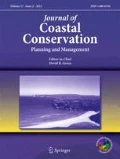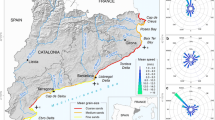Abstract
Management of coastal dunes on developed coasts could effectively take advantage of comprehensive and multitemporal georeferenced data collection, which offers the possibility to relate dune data with the natural and cultural characteristics of the beach and hinterland. The recent implementation of a coastal management geodatabase for the Veneto region provides the opportunity for improving knowledge on coastal dunes on developed littoral as well as a basis for appropriate future coastal planning in the study area. The geodatabase gathers data concerning different physical, evolutionary and human aspects of the coastal zone, with a special focus on coastal dunes. Established foredunes, human-altered dunes and relict dunes are irregularly distributed along 59 km, 38% of the entire coastal length. Their distribution and characteristics are the result of favourable natural conditions as well as long-lasting tourism exploitation (evaluated through an index of Land Use Pressure) and fragmentary and diversified uses of beaches (evaluated through an index of Tourism Pressure on the beach). At the same time, beach/dune nourishment intervention allowed the presence of artificial or sand fenced dunes along 17 km of coast. High dune elevation up to 8–10 m is promoted by the onshore exposition of the beach to dominant wind (from ENE), by stable-to-slowly negative sedimentary budget or by the re-activation of high relict foredunes in the case of shoreline retreat associated with strong negative budget. Present sedimentary budget (evaluated through the code ASPE – Accretion, Stable, Precarious, Erosive) is the tool used for dividing coasts in sedimentary compartments or cells. Past and present sedimentary budget and different human responses to erosive cases (hard and soft interventions) give the foredunes different means to form, grow, survive and evolve over time. The assessment of Human Impact and Active Management Practices on the dunes allows a first evaluation of the Management Effectiveness, which shows strong shortcomings for 81% of the dunes. The great variability of beach usage, human impact and management practises on the different dune stretches highlight the lack of effective and systematic management actions being correctly scheduled and performed.













Similar content being viewed by others
References
Antonioli F, Anzidei M, Amorosi A, Lo Presti V, Mastronuzzi G, Deiana G, De Falco G, Fontana A, Fontolan G, Lisco S, Marsico A, Moretti M, Orru PE, Serpelloni E, Sannino GM, Vecchio A (2017) Sea-level rise and potential drowning of the Italian coastal plains: flooding risk scenarios for 2100. Quat Sci Rev 158:29–43. https://doi.org/10.1016/j.quascirev.2016.12.021
Bezzi A, Fontolan G (2003) Foredune classification and morphodynamic processes along the Veneto coasts (N. Adriatic, Italy). Proc. VI International Conference on the Mediterranean Coastal Environment, MEDCOAST 03, Ravenna, Italy 7–11/10/2003 2: 1425–1434
Bezzi A, Boscolo F, Fontolan G (2005) Morphological and sedimentological monitoring of a man-induced accretionary beach-dune system (Ca’ Roman, Venice, Italy). In: Herrier JL, Mees J, Salman A, Seys J, Van Nieuwenhuyse H, Dobbelaere I (eds) Proc. international conference on nature restoration practices in European habitats, “Dunes and Estuaries 2005″, Koksijde, Belgium, 19–23/09/2005, VLIZ Spec Publication 19: 589–590
Bezzi A, Fontolan G, Delli Quadri F, Pillon S, Pilla G, Caiselli M (2008) Dune e strumenti di pianificazione: il piano dell’arenile del Lido di Venezia. Convegno Nazionale Coste Prevenire, Programmare, Pianificare 15-17 maggio 2008 Maratea. Autorità di bacino della Basilicata, Collana studi e ricerche 9:453–463
Bezzi A, Fontolan G, Nordstrom KF, Carrer D, Jackson NL (2009) Beach nourishment and foredune restoration: practices and constraints along the Venetian shoreline. J Coast Res SI 56:287–291
Carter RWG (1989) Coastal environments. Academic Press, London
Day JW Jr, Abrami G, Rybczyk, Mitsch W. (2005) Venice Lagoon and the Po Delta: system functioning as a basis for sustainable management. In: Fletcher CA and Spencer T (eds) Flooding and environmental challenges for Venice and its lagoon: state of knowledge. Cambridge University Press, Cambridge, pp 445–459
Fontolan G (2004) La fascia costiera. In: Bondesan A, Meneghel M (eds) Geomorfologia della provincia di Venezia. Note illustrative della carta geomorfologica della Provincia di Venezia. Esedra Editrice, Padova: pp 378–416
Fontolan G, Pillon S, Delli Quadri F, Bezzi A (2007) Sediment storage at tidal inlets in northern Adriatic lagoons: ebb-tidal delta morphodynamics, conservation and sand use strategies. Estuar Coast Shelf Science 75:261–277. https://doi.org/10.1016/j.ecss.2007.02.029
Fontolan G, Bezzi A, Pillon S (2011) Rischio da mareggiata. In: Vitturi A (ed) Atlante geologico della provincia di Venezia, Provincia di Venezia, Grafiche Erredici, Rubano Sarmeola (PD): pp 581–600
Fontolan G, Bezzi A, Martinucci D, Pillon S, Popesso C (2014) GCV Geodatabase gestionale delle coste venete. Technical Report, Regione del Veneto: 178 p. http://sistemavenezia.regione.veneto.it/sites/default/files/documents/08_Shape/RelazioneGCV-rev-ott2015_0.pdf. Accessed 16 Aug 2017
Fontolan G, Bezzi A, Martinucci D, Pillon S, Popesso C, Rizzetto F (2015) Sediment budget and management of the Veneto beaches, Italy: an application of the modified Littoral Cells Management System (SICELL). Coastal and Maritime Mediterranean Conference CM2, Ferrara 25–27/11/2015. Revue Paralia online: 47–50. https://doi.org/10.5150/cmcm.2015.010. http://www.paralia.fr/cmcm/e03-10-fontolan.pdf. Accessed 16 Aug 2017
Gómez-Pina G, Muñoz-Pérez JJ, Ramírez JL, Ley C (2002) Sand dune management problems and techniques, Spain. J Coast Res SI 36:325–332
Heslenfeld P, Jungerius PD, Klijn JA (2004) European coastal dunes: ecological values, threats, opportunities and policy development. In: Martínez ML, Psuty NP (eds) Coastal dunes, ecology and conservation ecological studies, 171. Springer-Verlag, Berlin Heidelberg, pp 335–351
Hesp PA (1989) A review of biological and geomorphological processes involved in the initiation and development of incipient foredunes. In: Gimmingham CH, Ritchie W, Willetts BB, Willis AJ (eds.) Coastal sand dunes, Proc R Soc Edin, 96B: pp 181–202
Hesp PA (2002) Foredunes and blowouts: initiation, geomorphology and dynamics. Geomorphology 48:245–268
Hesp PA (2011) Dune coasts. In: Wolanski E, McLusky DS (eds) Treatise on estuarine and coastal science, vol 3. Academic Press, Waltham, pp 193–221
Martucci G, Carniel S, Chiggiato J, Sclavo M, Lionello P, Galati MB (2010) Statistical trend analysis and extreme distribution of significant wave height from 1958 to 1999 – an application to the Italian Seas. Ocean Sci 6:525–538
Matias A, Ferreira O, Mendes I, Dias JA, Vila-Concejo A (2005) Artificial construction of dunes in the South of Portugal. J Coast Res 21(3):472–481
McKann MH, McAtee J, Campbell J, Seidensticker E, Quay R, Stafford C, Taylor J (2001) Coastal dunes. Dune protection and improvement manual for the Texas Gulf coast. Texas General Land Office, Austin, Texas. http://www.glo.texas.gov/coast/coastal-management/forms/files/dune-protection-manual-gpb.pdf. Accessed 16 Aug 2017
Nordstrom KF (2000) Beaches and dunes of developed coasts. Cambridge University Press, Cambridge
Nordstrom KF (2008) Beach and Dune Restoration. Cambridge University Press, Cambridge
Nordstrom KF, Gamper U, Fontolan G, Bezzi A, Jackson NL (2009) Characteristics of coastal dune topography and vegetation in environments recently modified using beach fill and vegetation plantings, Veneto, Italy. Environ Manag 44:1121–1135. https://doi.org/10.1007/s00267-009-9388-3
Priestas AM, Fagherazzi S (2010) Morphological barrier island changes and recovery of dunes after Hurricane Dennis, St. George Island, Florida. Geomorphology 114(4):614–626
Psuty NP (1988) Sediment budget and dune beach interaction. J Coast Res SI3:1–4
Psuty NP (1989) An application of science to the management of coastal dunes along the Atlantic coast of the U.S.A. Proc R Soc Edin 96B:289–307
Regione Emilia-Romagna (2011) Nuovi strumenti per la gestione dei litorali in Emilia – Romagna, SICELL il sistema gestionale delle celle litoranee. Servizio Difesa del Suolo della Costa e Bonifica, 61 p, http://ambiente.regione.emilia-romagna.it/suolo-bacino/sezioni/pubblicazioni/servizio-difesa-del-suolo-della-costa-e-bonifica/pdf/nuovi-strumenti-per-la-gestione-dei-litorali-in-emilia-romagna/view. Accessed 16 Aug 2017
Ruol P, Martinelli L, Favaretto C (2016) Gestione integrata della zona costiera. Progetto per lo studio ed il monitoraggio della linea di costa per la definizione degli interventi di difesa dei litorali dall’erosione nella Regione Veneto. Technical Report, Università degli Studi di Padova, Dipartimento ICEA, Regione del Veneto: 375 p
Sanjaume E, Pardo J (1992) The dunes of the Valencia coast (Spain): past and present. In: Carter RWG, Curtis TGF, Sheehy-Skeffington MJ (eds) Coastal dunes: geomorphology, ecology and management for conservation. AA Balkema, Rotterdam, pp 475–486
Short A, Hesp P (1982) Wave, beach and dune interactions in Southeastern Australia. Mar Geol 48(3–4):259–284
Townend IH, Fleming CA (1991) Beach nourishment and socio-economic aspects. Coast Eng 16:115–127
Tzatzanis M, Wrbka T, Sauberer N (2003) Landscape and vegetation responses to human impact in sandy coast of Western Crete, Greece. J Nat Conserv 11(3):187–195. https://doi.org/10.1078/1617-1381-00047
Zunica M (1971) Le spiagge del Veneto. Tipografia Antoniana, Padova, 144 p
Acknowledgements
This research has been supported by the Ritmare CNR flagship Project (as CoNISMa Consorzio Nazionale Interuniversitario per le Scienze del Mare partner), by IPA Adriatic SHAPE Project and by funds from a public contract with the Veneto Region. We wish to thanks Guido Selvi, Roberto Bertaggia and Roberto Piazza for encouraging the work and for the support given for data collection.
Author information
Authors and Affiliations
Corresponding author
Rights and permissions
About this article
Cite this article
Bezzi, A., Pillon, S., Martinucci, D. et al. Inventory and conservation assessment for the management of coastal dunes, Veneto coasts, Italy. J Coast Conserv 22, 503–518 (2018). https://doi.org/10.1007/s11852-017-0580-y
Received:
Revised:
Accepted:
Published:
Issue Date:
DOI: https://doi.org/10.1007/s11852-017-0580-y




